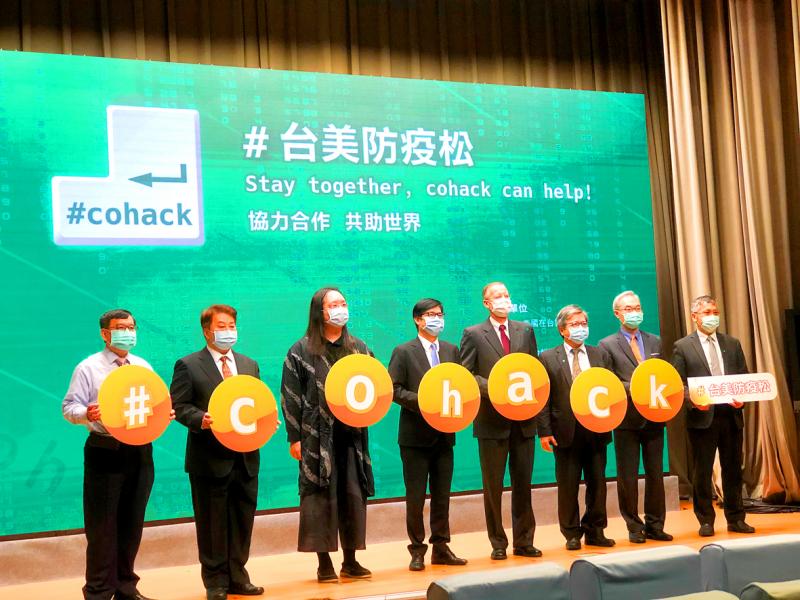The “Taiwan model” for combating COVID-19 is a roadmap for the world, American Institute in Taiwan (AIT) Director Brent Christensen said yesterday at the start of the Coronavirus Hackathon.
Christensen, speaking at the Executive Yuan, where officials were announcing the start of the hackathon — a public event sponsored by the AIT and the government to find ways to fight against the pandemic — said that the “Taiwan model” could be summarized in five Ts: transparency, transportation controls, tracking, testing and technology.
Taiwan has ensured transparency when sharing information about its approach to preventing the spread of the novel coronavirus and policies with the public — and the WHO, despite it unfairly excluding the nation, he said.

Photo: CNA
The nation’s authorities were among the first to begin screening flights, mandating quarantines for people arriving from high-risk areas, organizing safe transportation and monitoring people in quarantine, he added.
The authorities have meticulously tracked individuals who had a high risk of exposure to COVID-19 and enforced a targeted testing protocol based on rigorous contact tracing, Christensen said.
The model has used numerous technologies, such as tracing the movements of a confirmed case — using data from cell phone towers and then broadcasting messages to other mobile phones that were at the same places at that time — and using data analysis when implementing mask rationing, he said.
“Taiwan’s response to COVID-19 has been more successful than any in the world, according to nearly all available metrics,” and despite its proximity to China, he said.
The hackathon is designed to build on these successes to devise transportation-related innovations to ensure an optimal transition leading up to the listing of travel restrictions, as well as to protect essential workers and people who lack the means to access vital services, he said.
Officials hopes to learn from the hackathon how to use artificial intelligence and big data to develop predictive tools to track the virus much in the same way weather is forecast, providing policymakers and the public the information they need to respond and stay ahead of the curve to prevent COVID-19 from getting out of control, Christensen said.
The hackathon is intended to gather input about how to use these technologies to manage health resources across jurisdictions to ensure that front-line healthcare personnel are properly protected and that people are informed of pandemic risks while maintaining democratic values to hopefully elicit voluntary cooperation with the government’s disease prevention policies, he said.
He hopes that the hackathon would be another example of the fresh thinking that is only found in Taiwan, combining innovative technologies with a commitment to social good, he added.
Taiwan, as a member of the global community, hopes to engage with other nations to research vaccines, provide medical supplies and use technology to fight COVID-19, Vice Premier Chen Chi-mai (陳其邁) said.
The US is a world leader in pharmaceuticals and vaccine research and development, which coupled with Taiwan’s strengths in universal health insurance, and information and communication technologies, would help the world defeat COVID-19, he said.
The AIT and the Executive Yuan are seeking the public’s responses to questions about COVID-19 starting on May 5.

Trips for more than 100,000 international and domestic air travelers could be disrupted as China launches a military exercise around Taiwan today, Taiwan’s Civil Aviation Administration (CAA) said yesterday. The exercise could affect nearly 900 flights scheduled to enter the Taipei Flight Information Region (FIR) during the exercise window, it added. A notice issued by the Chinese Civil Aviation Administration showed there would be seven temporary zones around the Taiwan Strait which would be used for live-fire exercises, lasting from 8am to 6pm today. All aircraft are prohibited from entering during exercise, it says. Taipei FIR has 14 international air routes and

The Ministry of National Defense (MND) today released images of the military tracking China’s People's Liberation Army (PLA) movements during the latest round of Chinese drills around Taiwan. The PLA began "Justice Mission 2025" drills today, carrying out live-fire drills, simulated strikes on land and maritime targets, and exercises to blockade the nation's main ports. The exercises are to continue tomorrow, with the PLA announcing sea and air space restrictions for five zones around Taiwan for 10 hours starting from 8:30am. The ministry today released images showing a Chinese J-16 fighter jet tracked by a F-16V Block 20 jet and the

Snow fell on Yushan (Jade Mountain, 玉山) yesterday morning as a continental cold air mass sent temperatures below freezing on Taiwan’s tallest peak, the Central Weather Administration (CWA) said. Snowflakes were seen on Yushan’s north peak from 6:28am to 6:38am, but they did not fully cover the ground and no accumulation was recorded, the CWA said. As of 7:42am, the lowest temperature recorded across Taiwan was minus-5.5°C at Yushan’s Fengkou observatory and minus-4.7°C at the Yushan observatory, CWA data showed. On Hehuanshan (合歡山) in Nantou County, a low of 1.3°C was recorded at 6:39pm, when ice pellets fell at Songsyue Lodge (松雪樓), a

City buses in Taipei and New Taipei City, as well as the Taipei MRT, would on Saturday begin accepting QR code payments from five electronic payment providers, the Taipei Department of Transportation said yesterday. The new option would allow passengers to use the “transportation QR code” feature from EasyWallet, iPass Money, iCash Pay, Jkopay or PXPay Plus. Passengers should open their preferred electronic payment app, select the “transportation code” — not the regular payment code — unlock it, and scan the code at ticket readers or gates, General Planning Division Director-General Liu Kuo-chu (劉國著) said. People should move through the